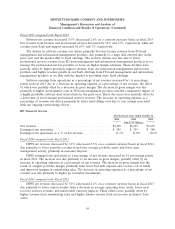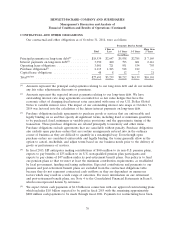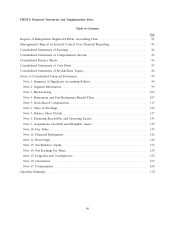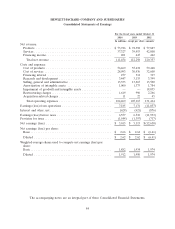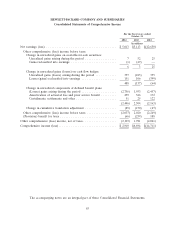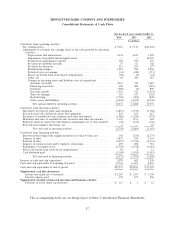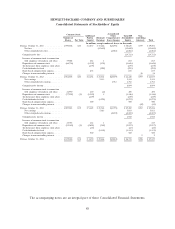HP 2014 Annual Report Download - page 86
Download and view the complete annual report
Please find page 86 of the 2014 HP annual report below. You can navigate through the pages in the report by either clicking on the pages listed below, or by using the keyword search tool below to find specific information within the annual report.ITEM 7A. Quantitative and Qualitative Disclosures About Market Risk.
In the normal course of business, we are exposed to foreign currency exchange rate and interest
rate risks that could impact our financial position and results of operations. Our risk management
strategy with respect to these market risks may include the use of derivative financial instruments. We
use derivative contracts only to manage existing underlying exposures. Accordingly, we do not use
derivative contracts for speculative purposes. Our risks, risk management strategy and a sensitivity
analysis estimating the effects of changes in fair value for each of these exposures is outlined below.
Actual gains and losses in the future may differ materially from the sensitivity analyses based on
changes in the timing and amount of foreign currency exchange rate and interest rate movements and
our actual exposures and derivatives in place at the time of the change, as well as the effectiveness of
the derivative to hedge the related exposure.
Foreign currency exchange rate risk
We are exposed to foreign currency exchange rate risk inherent in our sales commitments,
anticipated sales, anticipated purchases and assets and liabilities denominated in currencies other than
the U.S. dollar. We transact business in approximately 75 currencies worldwide, of which the most
significant foreign currencies to our operations for fiscal 2014 were the euro, the British pound,
Chinese yuan renminbi and the Japanese Yen. For most currencies, we are a net receiver of the foreign
currency and therefore benefit from a weaker U.S. dollar and are adversely affected by a stronger U.S.
dollar relative to the foreign currency. Even where we are a net receiver of the foreign currency, a
weaker U.S. dollar may adversely affect certain expense figures, if taken alone.
We use a combination of forward contracts and options designated as cash flow hedges to protect
against the foreign currency exchange rate risks inherent in our forecasted net revenue and, to a lesser
extent, cost of sales and intercompany loans denominated in currencies other than the U.S. dollar. In
addition, when debt is denominated in a foreign currency, we may use swaps to exchange the foreign
currency principal and interest obligations for U.S. dollar-denominated amounts to manage the
exposure to changes in foreign currency exchange rates. We also use other derivatives not designated as
hedging instruments consisting primarily of forward contracts to hedge foreign currency balance sheet
exposures. Alternatively, we may choose not to hedge the risk associated with our foreign currency
exposures, primarily if such exposure acts as a natural hedge for offsetting amounts denominated in the
same currency or if the currency is too difficult or too expensive to hedge.
We have performed sensitivity analyses as of October 31, 2014 and 2013, using a modeling
technique that measures the change in the fair values arising from a hypothetical 10% adverse
movement in the levels of foreign currency exchange rates relative to the U.S. dollar, with all other
variables held constant. The analyses cover all of our foreign currency derivative contracts offset by
underlying exposures. The foreign currency exchange rates we used in performing the sensitivity
analysis were based on market rates in effect at October 31, 2014 and 2013. The sensitivity analyses
indicated that a hypothetical 10% adverse movement in foreign currency exchange rates would result in
a foreign exchange fair value loss of $62 million and $80 million at October 31, 2014 and October 31,
2013, respectively.
Interest rate risk
We also are exposed to interest rate risk related to debt we have issued and our investment
portfolio and financing receivables.
We issue long-term debt in either U.S. dollars or foreign currencies based on market conditions at
the time of financing. We often use interest rate and/or currency swaps to modify the market risk
exposures in connection with the debt to achieve U.S. dollar LIBOR-based floating interest expense.
78


